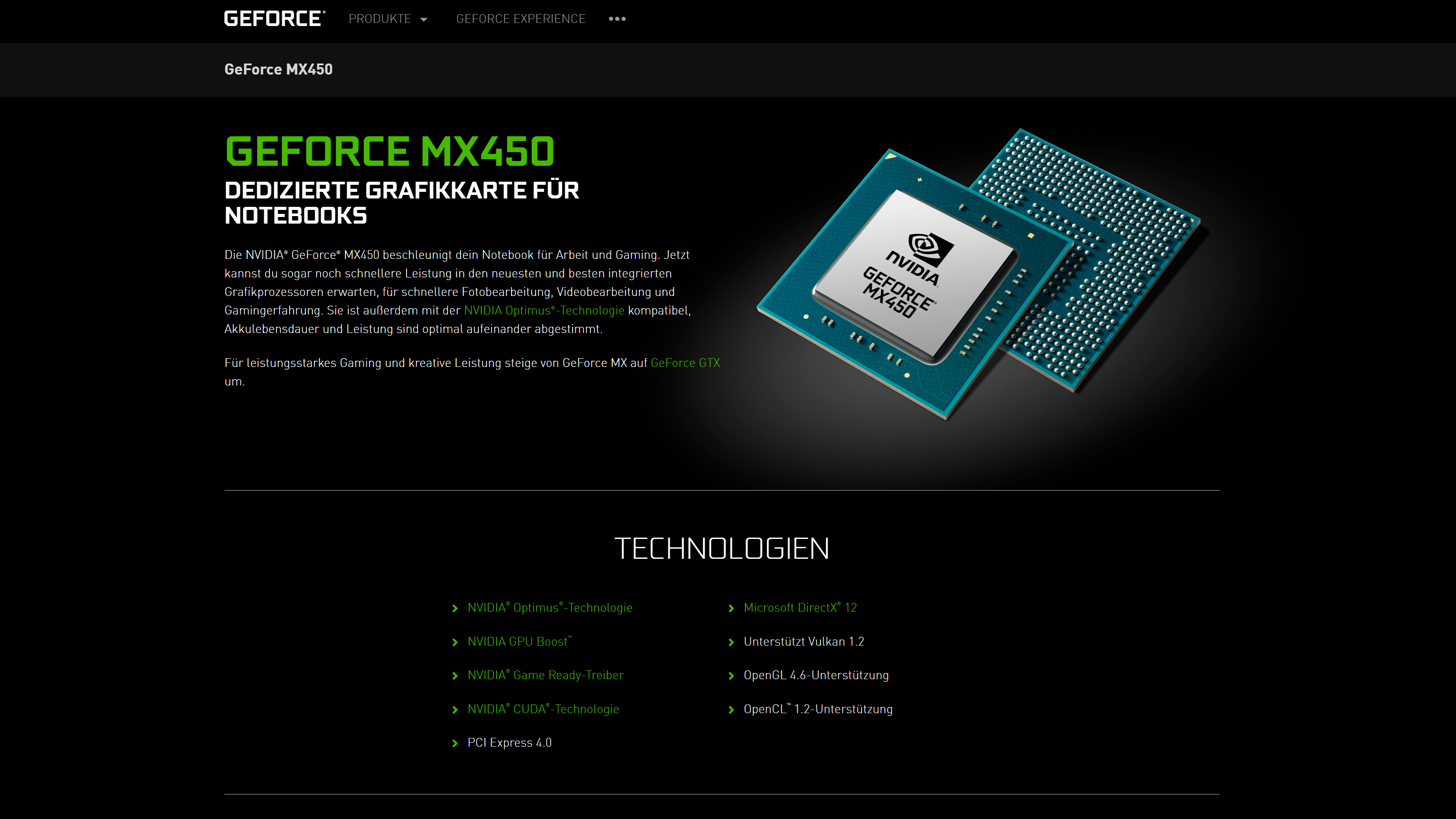Nvidia Product Page Reveals GeForce MX450 With PCIe 4.0 and GDDR6 Memory

As first spotted by ComputerBase, Nvidia's German division has published the product page for the GeForce MX450. More surprisingly, the entry-level mobile graphics card seems to come with support for PCIe 4.0 or so we are led to believe.
Nvidia's marketing says that the GeForce MX450 will provide improved performance over the current GeForce MX300-series for different workloads, including photo and video editing as well as gaming scenarios. The chipmaker just doesn't state how much higher performance, and it didn't provide any technical specifications either. Among the list of supported technologies, Nvidia mentioned PCIe 4.0, but we think the chipmaker might be alluding to Intel's 11th Generation Tiger Lake processors.
Laptop manufacturers love pairing Intel processors with Nvidia's GeForce MX-series graphics cards so you'll likely find the GeForce MX450 alongside some Tiger Lake processor in the foreseeable future. Perhaps, Nvidia intended to say that the GeForce MX450 works fine with processors that support PCIe 4.0 rather than stating that the graphics card actually takes advantage of the speedy interface.
Let's not forget that the GeForce MX450 is aimed at budget machines, so it doesn't make sense for it to come with PCIe 4.0 since the graphics card will probably not need that much bandwidth. Of course, supporting PCIe 4.0 on a mobile platform gives you bragging rights, but the reality of the situation is that it doesn't bring any substantial benefits and only sips unnecessary power. That's the reason why AMD left out PCIe 4.0 support on its latest Ryzen 4000-series (codename Renoir) chips.
None of Nvidia's current mainstream offerings leverage the PCIe 4.0 standard. Ampere should change that, but the GeForce MX450 is rumored to feature the TU117 die. The existing GeForce MX350 is still on Pascal so it's logical to expect its successor to land with a Turing silicon. We don't see the GeForce MX450 having PCIe 4.0, unless Nvidia equips it with an Ampere die, which is highly unlikely considering that the MX-series have historically been the last parts to jump to a new silicon platform.
The memory upgrade, on the other hand, should prove more useful for the GeForce MX450 in situations where memory bandwidth holds value. While the GeForce MX350 was stuck with GDDR5 memory, the GeForce MX450 should be able to support both GDDR5 and GDDR6 memory. The latter enables the GeForce MX450 to employ faster memory, and even if it's still constrained within a modest memory interface, the graphics card will enjoy a good boost in memory bandwidth.
Nvidia isn't fond of making a big deal out of low-end products, such as the MX-series. We're not even sure if we can even call this a launch, but for what it's worth, it shouldn't be long before the GeForce MX450 starts showing up in laptops.
Get Tom's Hardware's best news and in-depth reviews, straight to your inbox.

Zhiye Liu is a news editor, memory reviewer, and SSD tester at Tom’s Hardware. Although he loves everything that’s hardware, he has a soft spot for CPUs, GPUs, and RAM.
-
drtweak Does it need it? No. But then it would mean that it would require less PCIe lanes on a PCIe 4 CPU meaning things like more lanes or SSD's or maybe less lanes needed on the CPU itself bringing the cost down (Hopefully on that that one).Reply -
InvalidError Reply
PCIe lanes don't cost all that much, going from x16 to x8 likely shaves less than $5 all-inclusive off the GPU's cost.drtweak said:or maybe less lanes needed on the CPU itself bringing the cost down (Hopefully on that that one).
Also, laptop CPUs and GPUs already operate on cut-down PCIe lane counts to save power. -
salgado18 Reply
Then shave it down from 8x to 4x, and save more power and money. Even $5 on a budget gpu means a lot of money, because they are sold in large quantities.InvalidError said:PCIe lanes don't cost all that much, going from x16 to x8 likely shaves less than $5 all-inclusive off the GPU's cost.
Also, laptop CPUs and GPUs already operate on cut-down PCIe lane counts to save power.
Depending on gpu performance, I'd lower it down to 2x PCIex 4.0 lanes, if it doesn't become a bottleneck. -
mdd1963 ReplyAdmin said:Nvidia Germany has all the details on the chipmaker's entry-level MX450 mobile graphics card.
Nvidia Product Page Reveals GeForce MX450 With PCIe 4.0 and GDDR6 Memory : Read more
Someone will think PCI-e 4.0 sounds good on an entry level graphics card. to be sure...(sort of like having a 52X CD ROM drive 20 years back..) -
extremepenguin I would say for budget laptops it could be a useful thing to have, tracings are in short supply in budget portables so having the ability to cut down on actual PCIE lanes to cut costs with no noticeable performance degradation could be useful in hitting key price points.Reply -
Bobby Max ReplyLaptop manufacturers love pairing Intel processors with Nvidia's GeForce MX-series graphics cards so you'll likely find the GeForce MX450 alongside some Tiger Lake processor in the foreseeable future.
A mobile intel cpu? Absolutely disgusting and unusable. -
InvalidError Reply
The first thing that gets pared down on bottom-dollar GPUs is VRAM since it costs ~$10/GB. Once you get to 4GB or less, PCIe bandwidth becomes essential to let the GPU use system memory as an extra layer of cache before applications start constantly having to reload and re-send assets to the GPU. That's why the 4GB RX5500 fares a whole lot better against its 8GB counterparts on 4.0x8 than 3.0x8 by closing gaps most of the way and the 1650S holds up much better than 4GB RX5500/3.0x8 thanks to its 3.0x16 interface.salgado18 said:Then shave it down from 8x to 4x, and save more power and money. Even $5 on a budget gpu means a lot of money, because they are sold in large quantities.
Depending on gpu performance, I'd lower it down to 2x PCIex 4.0 lanes, if it doesn't become a bottleneck.
If you wanted to design the fastest bargain-basement GPU possible, you would end up with 2-3GB of VRAM for absolutely essential local heavy-lifting and 4.0x16 for the fastest access possible to system memory as scratch space since 4.0x16 is much cheaper than the 2-3GB of extra VRAM that would otherwise be required to max out the GPU cores of something approaching an RX5500. -
saunupe1911 Hopefully the laptop has HDMI 2.1 because that's the only thing that would make me upgrade!Reply -
hotaru251 does it need them?Reply
ofc not.
However by having it they can claim to have 4.0
intel is beign thrashed by Ryzen so anything to compete (such as gen 4pcie) they will do just to say it has it. -
nofanneeded Low Voltage CPU does not have much lanes available , so yes it is needed to use fewer lanes in any notebook . Add to it , high end Light notebooks are using two thunderbolts each consuming 4 lanes thats 8 lanes alone , two lanes for low voltage GPU , total 10 lanes and thats the max in low voltage CPU lanes.Reply
Moving to Gen 4 will solve alot of light notebooks bottleneck.
More over , Nvidia move hints at a secret mobile intel CPU with Gen4 lanes.
